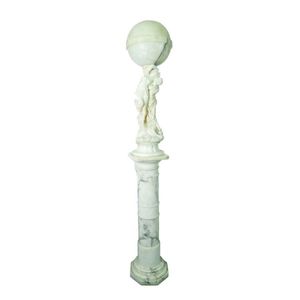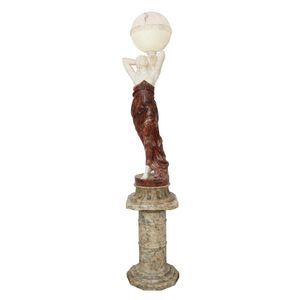Seminal Italian Marble Figural Lamp by Giuseppe Bessi
You must be a subscriber, and be logged in to view price and dealer details.
Subscribe Now to view actual auction price for this item
When you subscribe, you have the option of setting the currency in which to display prices to $Au, $US, $NZ or Stg.
- Agate - Agate is a type of semi-precious gemstone that is made up of silica dioxide, a mineral that is also found in quartz. It is known for its distinctive banded patterns, which are created as layers of silica are deposited in different colours including red, orange, yellow, green, blue, and purple. It is often used in jewellery, decorative objects, and other decorative items, and it is prized for its beauty and durability. Agate is found in many parts of the world, including Brazil, India, and the United States.
- School of .... - In the opinion of the cataloguer, a work by a pupil or follower of the artist.
- Art Nouveau Period - The Art Nouveau period was a cultural movement that emerged in the late 19th century, and was characterized by its emphasis on natural forms, flowing lines, and a decorative, ornamental style. Art Nouveau was a reaction against the ornate and heavily stylized designs of the previous era, and sought to create a new, more organic aesthetic.
Art Nouveau was characterized by its use of sinuous, curving lines, as well as a focus on natural elements such as flowers, vines, and other organic shapes. Art Nouveau designers sought to create a total work of art, in which every element of a building or object was designed to be harmonious with the overall design.
Some of the most iconic examples of Art Nouveau design include the Paris Metro entrances designed by Hector Guimard, the works of the artist Alphonse Mucha, and the architecture of Victor Horta in Brussels.
The Art Nouveau period was at its peak between 1890 and 1910, but began to decline in popularity by the start of World War I. However, Art Nouveau remains an important influence on design and art to this day, and continues to be celebrated for its emphasis on natural forms and decorative style. - Alabaster - Alabaster is soft natural stone used for statuary, with a similar appearance to marble, but easier to work with. As it is softer than marble, an item made from alabaster can be scratched with a metal object, and an alabaster item does not polish to a high surface gloss like marble.
Alabaster objects can be semi-translucent. Alabaster occurs in a pure white form and also with veining from dirt. Colours vary from white through yellow and pink to brown. The veining is usually green or black but can be multicoloured.
Being semi-translucent, alabaster is often used for the bowls of figural lamps, with the figure itself being either alabaster or marble.
This item has been included into following indexes:
Visually similar items

A late 19th century Italian alabaster statuette lamp on column stand, the lamp base carved as two lightly draped figures supporting a spherical shade encircled by a band of laurel leaves, supported from a fluted socle base upon a tall tapering cylindrical

An Italian marble sculpture of a semi nude female on pedestal, signed Allegrain. The pedestal 95.5 cm high, 40 cm diameter. The figure 86 cm high

A carved marble classical nude statue on turned marble pedestal, 19th century, (damaged fingers), 154 cm (Statue: 61 cm)

A circular silver giltwood marble top table, continental, 19/20th century, 79 high, 120 diameter
